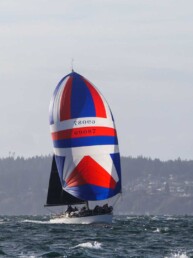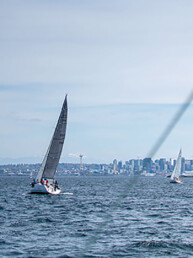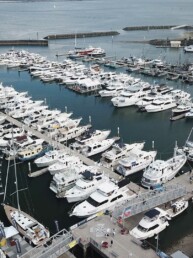
Whenever the small engine on my Uncle Jess’ Chris-Craft stalled, he’d remove the cowling and work some mechanical magic with a screwdriver to get it started again. Not one for regular maintenance, my uncle learned about every part of the boat through failed systems and trial and error. Long before the days of YouTube and Amazon Prime, Jess relied on duct tape, tie wire and a big hammer to assist him in most repairs. He had the confidence and carefree attitude to believe that he could deal with whatever problem arose on his boat or car. There have been many times when I wished that I had some of my uncle’s approach to life.
When my wife, Laura, and I bought Ariel, our 1973 28-foot Columbia sloop, we had hoped that having a small outboard engine might mitigate many of the problems associated with a massive inboard diesel engine. We knew nothing about diesels, but nearly everyone we spoke to said that they were almost maintenance-free and would run forever. That bit of urban legend belied the experience of a new sailing friend who recounted tales of frustration with his Iron Genny over the past year, spending thousands of dollars on the repair of his engine’s transmission and drive shafts. So buying a boat with an engine that could be “easily” brought to a repair shop in the back of our minivan seemed like a good fit for new sailors like ourselves.
Still, we should have been more aware of possible problems for the small gas-powered engine when the previous owner was unable to fire it up during our first examination of Ariel. We came back the following day to learn that the problem seemed to have been remedied with a swap of the old gas in the tank with a fresh batch. And sure enough, the small four-stroke outboard was trouble-free for about three months. Then I unintentionally found myself in the middle of a crash course on engine troubleshooting when the sputtering engine echoed like thunder as we returned to port after one of our short sailing adventures on Puget Sound.
Whether you’re gripping the steering wheel of a car or the tiller of a boat, the sound of a sputtering engine can instantly send worry, apprehension and even fear throughout your mind and body. Uncertainty about the safety of your location, the time that it may take for a tow vehicle to arrive, and the cost and downtime needed for repairs may all loom large. And having a vessel that is unfamiliar only adds to that fear of the unknown. Well, at least it did for Laura and me in the first few months of owning Ariel, with its 9.9-horsepower Yamaha engine.
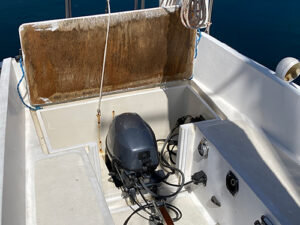
As we researched possible reasons for engine malfunction and asked our helpful and knowledgeable dock mates, Tom and Fred, we seemed convinced that water in the fuel tank was the culprit, though how it got there was a mystery to us. And the solution was not as easy as replacing the gas or adding fuel stabilizer to the tank, leading us to a two-month problem-solving excursion that provided me with “opportunities” to learn about fuel filters, carburetors, and gas tanks. I think Sisyphus may have had an easier time pushing his boulder uphill than I did trying to repair that Yamaha. While my heavy load didn’t roll back on me, hoisting it out of the well from the aft section of the cockpit nearly felt like it, and the engine seemed to resist every attempt I made to restore it to working order.
I first learned from another dockmate that despite removing water from the tank, the carburetor might still contain a residual amount of H2O and would require draining. When I responded to him with a deer-in-the-headlights look, he said all I needed to do was remove the small hex plug below the carb and any water-polluted fuel would trickle out onto the special gas absorbent cloth that I had stuffed below the drain hole. He offered me a 10 mm open-ended wrench for the job and sat on the dock providing moral support for the task.
Believing that the problem had finally been resolved, Laura and I were shocked and shaken when the engine died as we backed out of our slip the following day, causing Ariel to slowly drift toward a J/36 at the end of the dock. Reminding ourselves that everything was going to be all right, we overcame our momentary panic and were able to easily push off the starboard side of the larger boat from our stern. I repeatedly tried starting the engine and was tremendously relieved when it finally turned over, allowing us to sheepishly return Ariel to her home. I decided it was time to call the local boat repairman to take over.
Derek inspected the Yamaha thoroughly, then suggested draining the tank to remove any water or debris. After seeing the sludge that was removed from the bottom of the tank, Laura and I once again thought we had discovered the source of the problem and figured we were now good to go.
We set out for a sail the next day, enjoying variable winds on Commencement Bay until dropping the sails and firing up the engine. The Yamaha seemed fine … until it suddenly died about a quarter-mile from the marina. We hailed a passing fishing boat, which was kind enough to tow us to the marina’s guest dock.
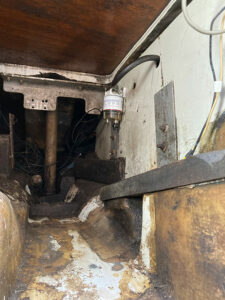
Back to the drawing board! When I went to the local marine engine supply store and described my problem to the owner, he said an engine working at high throttle but stalling at low RPMs might be the result of clogged carburetor jets, and that I should remove the entire carburetor and bring it in for a sonic cleaning. After YouTubing carburetor removal and cleaning, I took the plunge and carefully followed the tutorials, taking photos at every step, and brought the part in as the technicians suggested. But even after replacing the refurbished carb and installing a new fuel filter/water separator, the little engine that could, didn’t.
After climbing around in the cave below the cockpit where the original diesel once lived, I finally discovered the source of the problem. Tucked high along an interior partition wall was another fuel filter/water separator, one that looked like it had not been changed or cleaned this century. Upon draining the water separator cup into a jar, I was confused when examining the liquid. The telltale water bubble at the bottom of the jar that indicates water intrusion was not apparent. I realized that the liquid was entirely water!
Then, upon removing the filter with a Herculean effort, the source of our engine problem became even more apparent. The fuel in the filter itself, if it could be called that, resembled sludge from the bottom of a lake more than gasoline for an engine. And further down in the line, nearer the gas tank, was a fuel pump left over from Ariel’s days with a diesel engine, a now vestigial part no doubt filled with debris that was probably blocking the flow along the gas line as well.
Another trip to the marine engine store resulted in a new water separator, a clean carburetor from the prior visit, and an engine-mounted gas filter for good measure. After installing the new parts, priming the water separator, and crossing my fingers, the little Yamaha that could finally did! It purred like a kitten after I adjusted the throttle set screw. We tested the engine under load while tied up in our berth, and satisfied that it wouldn’t die, set out for a short and successful test run.
I wouldn’t have known about the hidden filter below the cockpit without searching for the root of our engine’s problem, and I certainly would never have been confident enough to remove the carburetor without the support from friends, technicians, and YouTube. I’m not quite ready to jury-rig a solution to a consistent problem the way Uncle Jess did, but I now understand a little better why he wasn’t too concerned about problems.
After getting my hands dirty and my knuckles scraped, I understand Ariel a little better than I did before. And my knowledge of her inner workings has given me the peace of mind to enjoy what she has to offer, whether she moves through the water under power, paddle, or sail.
David Casey is a retired math teacher and semiprofessional woodworker and bass player. He plans on using his retirement to build a small sailboat and a kayak, and to explore the waters of southern Puget Sound.

